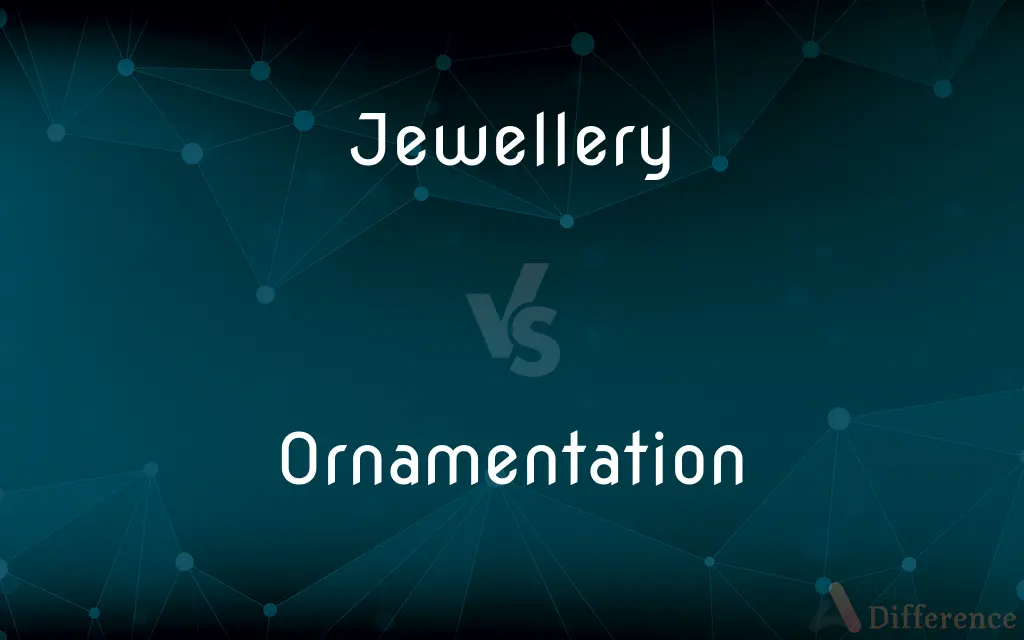Jewellery vs. Ornamentation — What's the Difference?
By Tayyaba Rehman — Updated on September 25, 2023
Jewellery refers to decorative items worn for personal adornment, typically made from gems and precious metals. Ornamentation is the act or process of decorating, adorning, or embellishing, applicable to various contexts, not just personal adornment.

Difference Between Jewellery and Ornamentation
Table of Contents
ADVERTISEMENT
Key Differences
Jewellery and ornamentation, while interconnected, have distinct applications and meanings. Jewellery typically denotes objects, such as rings, necklaces, and bracelets, worn for personal adornment. These items are often crafted from precious metals and gemstones, symbolizing wealth, status, or personal significance. Jewellery serves both decorative and functional roles, enhancing aesthetic appeal while often holding sentimental or intrinsic value.
Conversely, ornamentation transcends the realm of personal adornment. It encompasses the broader act or process of decorating, embellishing, or adorning. Ornamentation can manifest in architectural details, musical embellishments, and decorative elements in various art forms. It implies the enhancement of appearance and aesthetic appeal through added details, whether they are visual, auditory, or tactile, contributing to the overall perception and experience of beauty.
Jewellery is a subset within the larger category of ornamentation, restricted to wearable items of adornment. It is a tangible representation of ornamentation, where the decorative elements are designed to enhance personal appearance. The crafting of jewellery involves meticulous attention to detail, artistic design, and often, the use of valuable materials, resulting in pieces that are both visually appealing and cherished.
In contrast, ornamentation is a versatile and multifaceted concept, applicable to diverse fields and mediums. It can refer to the intricate patterns on textiles, the elaborate details on buildings, or the decorative notes in a musical composition. It is not confined to tangible objects but extends to any form of embellishment or decoration that enhances the aesthetic value of the underlying subject.
In conclusion, while jewellery is a specific form of decorative adornment worn by individuals, ornamentation is a comprehensive term denoting any form of embellishment or decoration. Jewellery represents a tangible, often valuable, manifestation of ornamentation focused on personal adornment, whereas ornamentation extends to encompass a myriad of decorative enhancements in various domains and mediums, enriching our sensory experiences and perceptions of beauty.
ADVERTISEMENT
Comparison Chart
Definition
Objects worn for personal adornment, typically made from precious metals and gems.
The act or process of adding decorative elements to enhance aesthetic appeal.
Scope
Specific to wearable items.
Applicable to various contexts including architecture, music, and art.
Tangibility
Tangible objects like rings, necklaces, and bracelets.
Can be tangible or intangible, depending on the context.
Application
Personal adornment.
Any form of decoration or embellishment in various domains.
Material
Often made from precious metals and gemstones.
Can be made from various materials, or be a conceptual embellishment like in music.
Compare with Definitions
Jewellery
Decorative items, like rings or necklaces, usually made from precious metals and stones, and worn for adornment.
She wore a piece of antique jewellery, a beautiful ruby necklace, to the event.
Ornamentation
The process or art of decorating or adorning.
The ornamentation of the palace includes intricate carvings and elaborate frescoes.
Jewellery
Personal adornments that are often valuable due to materials and craftsmanship.
His collection of jewellery includes several rare and exquisite pieces.
Ornamentation
Architectural features added to buildings to enhance their visual appeal.
The ornamentation on the facade gives the building its distinctive character.
Jewellery
Wearable objects designed to decorate and enhance personal appearance.
She designs unique jewellery that reflects her artistic sensibility.
Ornamentation
Decorative elements added to enhance aesthetic appeal.
The elegant ornamentation of the manuscript made it a priceless artifact.
Jewellery
Artistic creations worn for personal embellishment, expressing style, status, or symbolism.
The royal jewellery is a symbol of elegance and sovereignty.
Ornamentation
Embellishments in music, added to make the piece more expressive.
The pianist’s ornamentation added a unique flair to the composition.
Jewellery
Items of adornment, often containing gems, precious metals, or other valuable materials.
The jewellery in the museum showcases various civilizations’ craftsmanship and aesthetic preferences.
Ornamentation
Any added detail or feature designed to improve appearance or aesthetic value.
The subtle ornamentation of the dress elevated its elegance.
Jewellery
Jewellery or jewelry consists of decorative items worn for personal adornment, such as brooches, rings, necklaces, earrings, pendants, bracelets, and cufflinks. Jewellery may be attached to the body or the clothes.
Ornamentation
The act or process of decorating, adorning, or embellishing.
Jewellery
Personal ornaments, such as necklaces, rings, or bracelets, that are typically made from or contain jewels and precious metal
She had silver hair and chunky gold jewellery
A jewellery box
Ornamentation
The state of being decorated, adorned, or embellished.
Jewellery
Collectively, personal ornamentation such as rings, necklaces, brooches and bracelets, made of precious metals and sometimes set with gemstones.
She had more jewellery ornamented about her than any three ladies needed.
Ornamentation
Something that decorates or adorns; an embellishment.
Jewellery
See Jewelry.
Ornamentation
Decoration, adornment or embellishment.
Jewellery
An adornment (as a bracelet or ring or necklace) made of precious metals and set with gems (or imitation gems)
Ornamentation
The act or process of decorating etc.
Ornamentation
(music) Short notes added to a composition to emphasize certain notes and to add style.
Ornamentation
The act or art of ornamenting, or the state of being ornamented.
Ornamentation
That which ornaments.
Ornamentation
The ornaments embellishing an object, collectively; as, each room of the palace had a strikingly different ornamentation.
Ornamentation
The state of being ornamented
Ornamentation
Something used to beautify
Ornamentation
The act of adding extraneous decorations to something
Common Curiosities
Can ornamentation include things other than visual enhancements?
Yes, ornamentation can include enhancements in various forms, such as visual, auditory, and tactile.
Is jewellery only referred to as wearable items?
Yes, jewellery typically refers to decorative items worn for personal adornment.
Can ornamentation be applied to music?
Yes, in music, ornamentation refers to the addition of decorative notes to enhance expressiveness.
Is all jewellery considered a form of ornamentation?
Yes, all jewellery is a form of ornamentation as it involves adding decorative elements for adornment.
Can jewellery have functional aspects in addition to being decorative?
Yes, some jewellery can serve functional purposes, such as brooches that secure clothing or watches that tell time.
Can ornamentation be found in architecture?
Yes, ornamentation in architecture includes decorative elements added to buildings to enhance their aesthetic appeal.
Can jewellery be made from non-precious materials?
Yes, jewellery can be made from a variety of materials, not limited to precious ones, such as plastic, glass, or leather.
Does ornamentation always involve tangible additions?
No, ornamentation can be intangible, such as decorative notes in music or stylistic flourishes in writing.
Can ornamentation refer to enhancements in literature and writing?
Yes, in literature, ornamentation can refer to stylistic additions and flourishes that enhance the expressiveness or beauty of the writing.
Does ornamentation always improve the appearance of an object or can it be excessive?
While the intent of ornamentation is often to enhance appearance, it can be considered excessive or detrimental to aesthetic appeal in some opinions.
Can jewellery be symbolic or hold sentimental value?
Absolutely, jewellery often holds symbolic meanings or sentimental value, representing relationships, commemorating events, or symbolizing beliefs.
Is the concept of ornamentation limited to any specific fields or domains?
No, the concept of ornamentation is versatile and can be applied across various domains including art, music, architecture, and literature.
Is jewellery always expensive?
No, the value of jewellery can vary widely, from inexpensive costume pieces to high-value items made from precious materials.
Can the craftsmanship of jewellery be considered a form of art?
Yes, the design and creation of jewellery involve artistic expression and craftsmanship, and it is often considered a form of art.
Is the term ‘jewellery’ inclusive of a wide range of items?
Yes, ‘jewellery’ can include a diverse range of items such as rings, necklaces, bracelets, earrings, and brooches, among others.
Share Your Discovery

Previous Comparison
Ministry vs. Department
Next Comparison
Clearly vs. ClearAuthor Spotlight
Written by
Tayyaba RehmanTayyaba Rehman is a distinguished writer, currently serving as a primary contributor to askdifference.com. As a researcher in semantics and etymology, Tayyaba's passion for the complexity of languages and their distinctions has found a perfect home on the platform. Tayyaba delves into the intricacies of language, distinguishing between commonly confused words and phrases, thereby providing clarity for readers worldwide.
















































